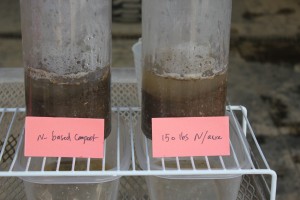I really can’t believe I’m in my 9th week of my internship-it’s all gone by so fast! The past two weeks I’ve spent a great deal of time preparing extension materials. Although it was great to present our studies to the local farming community at the field day two weeks ago, field days are certainly not the only way to connect with farmers to share our findings! The NMSP publishes scientific papers to journals often, but we also try to accompany these papers with extension documents of various sorts to be able to share with farmers from all over NY state.
The first extension material I’ve been working on is an agronomy fact sheet. The topic I’ve been writing about is aggregate stability with manure management. Aggregate stability is such an important component of soil health because it dictates and is impacted by several other soil properties such as: pore space, infiltration, organic matter, etc. Although many inherent properties of the soil will affect aggregate stability, we can manage fields in a way that favors the building of aggregate stability. For example, we have found that by adding organic sources of nutrients, such as liquid manure or composted manure, to a corn/alfalfa rotation, we can improve aggregate stability and the overall health of the soil.

Infiltration and aggregate stability differences between soil treated with compost and soil treated with inorganic fertilizer
The second extension material I’ve been focusing on is a What’s Cropping Up? article summarizing our paper on soil properties. What’s Cropping Up? is a bi-monthly digital newspaper distributed by Cornell’s Soil and Crop Sciences department targeting farmers and farm advisors. The goal is to give an easy to understand, concise summary of published journal articles. We are working on finish an article about soil health changes when shifting form N-based to P-based manure and compost application rates.
In the coming week we hope to put together a video clip demonstrating infiltration differences between a soil treated with inorganic nutrients and soil treated with organic sources of manure. In practice, we have seen stark differences and really want to show people how much of a difference 15 years of applying organic sources of nutrients can make on a field.
Hopefully these materials will be useful to farmers across NY in making the best management decisions for their fields!
